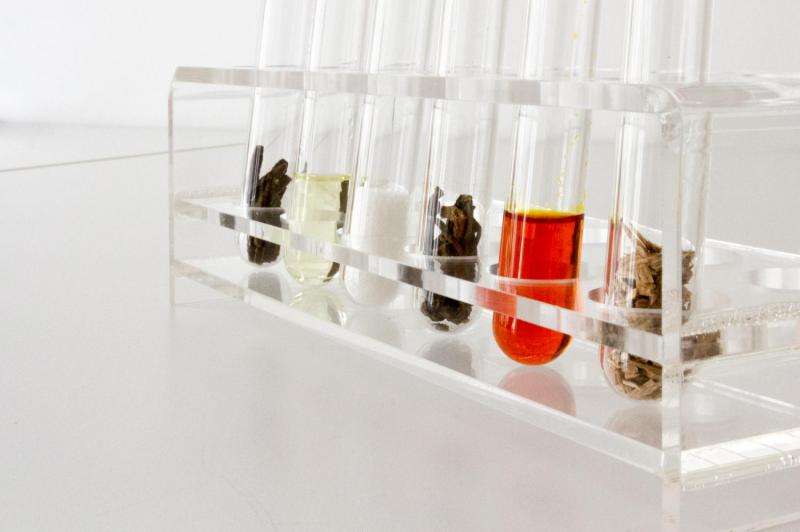Various raw materials as building blocks for plastics. Credit: Fraunhofer IGB
Fraunhofer researchers have developed a process for the manufacturing of high-quality plastics from terpenes, a waste stream of the cellulose production. They will present their new bioplastic and its possible applications from October 19 – 26 at the K 2016 trade fair in Düsseldorf. Visitors can find the joint Fraunhofer booth in Hall 7, Booth SC01.
Even if fossil resources got much cheaper in the last years there are big efforts to replace standard plastics by substances made from renewable resources. A reduced consumption of fossil resources is especially important because of the climate change caused by the release of carbon dioxide. Apart from the production of biodegradable polymers, for example for packaging applications, there is a big interest in high performance materials made from renewable resources.
The synthesis of polyamides from terpenes was developed at BioCat – Bio, Electro and Chemocataysis, the Straubing branch of Fraunhofer IGB. BioCat, headed by Professor Volker Sieber works on techniques for converting terpenes – a side stream of the cellulose production from wood – into biosurfactants, biobased epoxides or monomers for biobased polyamides with new properties (see also the boxes "What are terpenes?" and "Polyamides made of 3-carene"). "Because of the special chemical structure of terpenes, polyamides from 3-carene based lactams are highly transparent," explains project manager Dr. Harald Strittmatter. "This gives the possibility of new applications, like ski goggles or visors of helmets." It will be possible to manufacture products like coatings, textiles and adhesives from the biobased polyamides.
Enzymes and harmless reagents instead of toxic chemicals
Why are the Fraunhofer researchers working with terpenes? "It's a renewable resource that is generated in large quantities as a side stream of the pulp production as well as in the fruit industry. As a waste stream the application of terpenes for the production of new bio-plastics is in no conflict with the need of food production for humans and animals" explains Dr. Strittmatter. Today big amounts of the terpenes available are not used as a valuable biobased raw material but incinerated for the energy supply of the pulp mills. Because of the complex structure of the terpenes, a much higher value application is desirable. "Similar compounds are only accessible from fossil resources with great effort," Dr. Strittmatter says. The structure of terpenes allows polyamides with special characteristics, such as high transparency. For the synthesis of polyamides, terpenes have to be modified. By an oxidation step, a so called carbonyl group is introduced, which can be converted into a lactam, a monomer building block of polyamides. The benefits of the process: The synthetic route for the production of terpene-based lactams is shorter and – even more important – combines bio- and chemocatalytic reaction steps which allow avoidance of harmful reagents.
Up to now, these biobased plastics have been manufactured only in the laboratory; although the plan is to develop a synthetic route which allows a future production in industrial scale. However, Dr. Strittmatter and his team intend to make a contribution to the replacement of fossil based chemicals with renewable resources.
What are terpenes?
Terpenes are hydrocarbons. The word is related to the Greek word "terpein," meaning "to enjoy" – which points to the fact, that many terpenes have a nice smell, just think of turpentine, mostly used as a solvent for resins and paint. In nature there are many different sources of terpenes, in particular as components of softwood. But the substances can also be found in dandelions, rubber trees and spices such as aniseed, cloves, nutmeg, cardamom, cinnamon and allspice. Slightly volatile terpenes are referred to as essential oils, which can be obtained, for example, from the peel of citrus fruits during the manufacture of orange juice or tinned fruit.
Polyamides made of 3-carene
Polyamide 6 (PA6) is one of the most important polyamides. It is used for example for higher-quality materials, such as in vehicle manufacturing. In contrast to PA6 a derivative synthesized from the terpene 3-caren is significantly more transparent, making it suitable for new and high quality applications, for example the production of ski goggles or visors of helmets.
Provided by Fraunhofer-Gesellschaft























